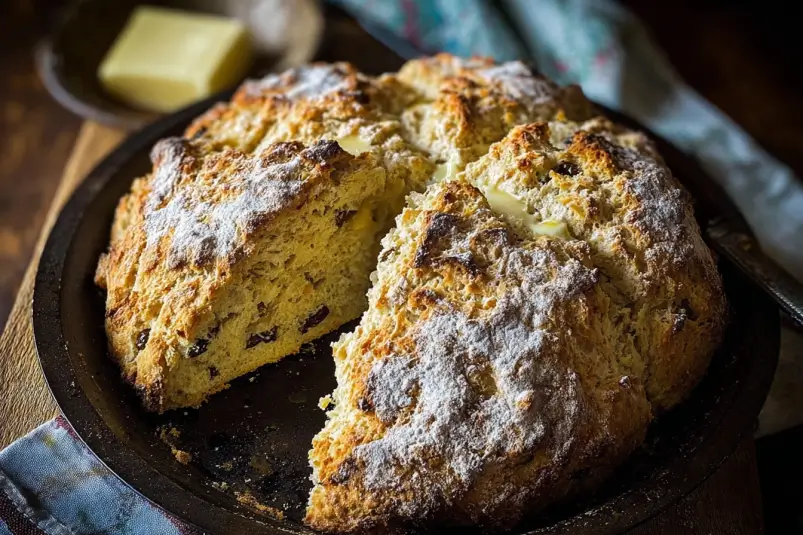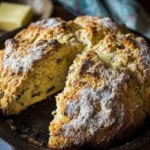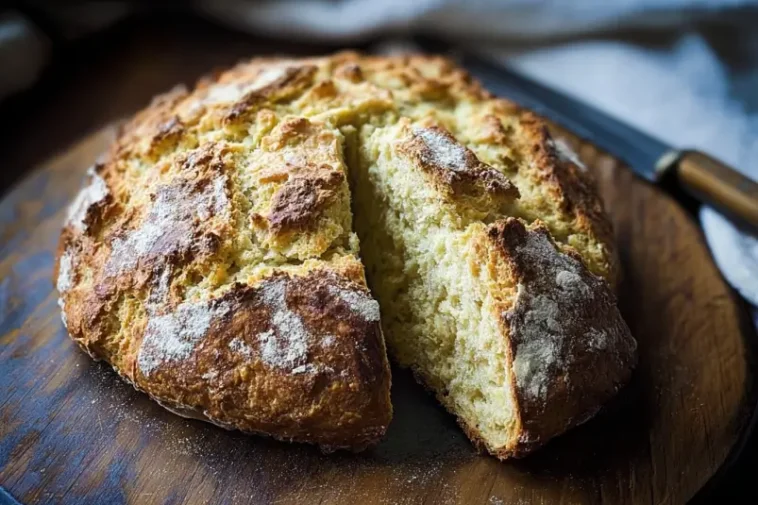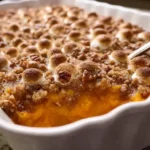Few recipes capture the essence of Irish home cooking like Irish Soda Bread. Born out of necessity rather than indulgence, this humble bread relies on baking soda instead of yeast, giving it a distinctive texture and tangy flavor. The beauty of soda bread lies in its simplicity—it requires no kneading, no proofing, and no special equipment. With just a handful of pantry staples, anyone can bake a hearty loaf that pairs perfectly with soups, stews, or even a slab of butter and jam. Whether you’re new to baking or an experienced home cook, this traditional recipe delivers a quick, reliable, and deeply satisfying result.
Ingredients
To make one classic loaf of Irish Soda Bread, gather the following ingredients:
- 4 cups (500g) all-purpose flour – provides structure and body
- 1 teaspoon salt – enhances flavor
- 1 teaspoon baking soda – the leavening agent that reacts with buttermilk
- 1¾ cups (420ml) buttermilk – adds moisture and acidity
- (Optional) 2 tablespoons sugar – for a slightly sweeter loaf
- (Optional) 2 tablespoons unsalted butter, melted – for a richer taste
- (Optional) ½ cup (75g) raisins or currants – for a traditional “spotted” bread variation
These simple ingredients are the backbone of soda bread. The buttermilk reacts with baking soda to produce carbon dioxide, which causes the dough to rise. This reaction happens quickly, which is why soda bread is often categorized as a “quick bread.”

Instructions
Step 1: Preheat the Oven
Set your oven to 425°F (220°C) and allow it to fully preheat. Prepare a baking sheet by lightly dusting it with flour or lining it with parchment paper. This prevents sticking and helps achieve a crisp crust.
Step 2: Mix the Dry Ingredients
In a large mixing bowl, combine the flour, salt, and baking soda. Use a whisk or your hands to mix them evenly. This ensures that the baking soda distributes throughout the flour, preventing uneven rising.
Step 3: Add the Wet Ingredients
Create a well in the center of the flour mixture and pour in most of the buttermilk (reserve about ¼ cup). If you’re adding melted butter or sugar, include them at this stage. Stir with a wooden spoon or your hand in a claw-like motion until the dough starts to come together. Add the remaining buttermilk as needed—only enough for the dough to be slightly sticky but not wet.
Step 4: Form the Dough
Turn the dough onto a lightly floured surface. Gently bring it together with your hands. Avoid kneading; overworking the dough toughens the bread. Form it into a round loaf about 7 inches (18 cm) in diameter and 1½ inches (4 cm) thick.
Step 5: Score the Dough
Place the dough on the prepared baking sheet. Using a sharp knife, cut a deep cross (about ½ inch deep) across the top. This traditional step allows heat to penetrate the center and ensures even baking. According to Irish folklore, it also “lets the fairies out,” keeping the bread light.
Step 6: Bake
Bake in the preheated oven for 15 minutes at 425°F (220°C). Then reduce the temperature to 400°F (200°C) and bake for another 25–30 minutes, or until the loaf sounds hollow when tapped on the bottom. If the crust browns too quickly, loosely cover it with aluminum foil.
Step 7: Cool and Serve
Transfer the baked loaf to a wire rack and let it cool for at least 30 minutes before slicing. This resting period allows the crumb to set and the flavors to deepen.
Conservation and Storage
Irish Soda Bread tastes best the day it’s baked, as it tends to dry out quickly due to its lack of preservatives. However, you can store it properly to extend freshness:
- Room Temperature: Wrap the cooled loaf in a clean kitchen towel and store it in an airtight container for up to 2 days.
- Freezing: Wrap the loaf tightly in plastic wrap, then in foil, and freeze for up to 2 months. When ready to eat, thaw it at room temperature and reheat in a warm oven (300°F / 150°C) for 10–15 minutes.
- Avoid Refrigeration: Refrigeration accelerates staling and should be avoided.
Variations
Soda bread’s versatility allows for several regional and creative variations:
- Brown Soda Bread: Replace half or all of the all-purpose flour with wholemeal (whole wheat) flour. Add a tablespoon of rolled oats for extra texture.
- Spotted Dog: Incorporate raisins or currants for a subtly sweet version that pairs well with butter and tea.
- Savory Herb Bread: Add chopped rosemary, thyme, or chives to the dry mix, and sprinkle coarse salt on top for a fragrant loaf.
- Seeded Version: Mix in sunflower, sesame, or caraway seeds for nutty flavor and crunch.
- Gluten-Free Soda Bread: Substitute a gluten-free flour blend and add 1 teaspoon of xanthan gum for structure.
These variations show how soda bread can shift from rustic to refined with minor tweaks, making it suitable for both everyday meals and festive occasions.
Serving Suggestions
Irish Soda Bread pairs beautifully with both sweet and savory dishes:
- Breakfast: Serve warm slices with butter, honey, or jam alongside tea or coffee.
- Lunch or Dinner: Use it to accompany hearty stews, soups, or chowders—its dense crumb absorbs broth without falling apart.
- Appetizer: Toast slices and top with smoked salmon, cream cheese, or pâté for a refined starter.
- Dessert Twist: Spread slices with clotted cream and marmalade for a comforting treat.
The bread’s mild tang complements rich and creamy dishes, balancing flavors and adding substance to any meal.
Tips for Perfecting the Dish
- Use fresh baking soda. Stale soda reduces rise and leads to dense bread.
- Don’t overmix. Stop stirring as soon as the dough forms.
- Work quickly. Once the buttermilk reacts with baking soda, the leavening begins immediately.
- Maintain high oven temperature. The initial heat boost creates a firm crust and light interior.
- Test doneness by tapping. A hollow sound signals a fully baked loaf.
Following these details ensures your bread stays moist inside with a crisp, golden crust.
Conclusion
Irish Soda Bread represents the heart of traditional Irish baking: resourceful, unfussy, and flavorful. Its quick preparation and reliable rise make it ideal for busy cooks seeking homemade comfort without the wait. Whether enjoyed plain, sweetened, or enriched with seeds and herbs, it remains a versatile staple suited for every occasion. Once mastered, this recipe becomes more than just bread—it becomes a symbol of simplicity, warmth, and the enduring appeal of homemade food.
Print
Irish Soda Bread Recipe: A Rustic Taste of Tradition
- Total Time: 50 minutes
- Yield: 1 loaf (serves 8) 1x
- Diet: Vegetarian
Description
This traditional Irish Soda Bread is a simple, no-yeast bread made with basic pantry ingredients. Using baking soda and buttermilk for leavening, it bakes into a crusty, tender loaf with a rich, tangy flavor. Quick to prepare and deeply satisfying, it’s perfect for breakfast, alongside hearty soups, or simply enjoyed warm with butter.
Ingredients
4 cups (500g) all-purpose flour
1 teaspoon salt
1 teaspoon baking soda
1¾ cups (420ml) buttermilk
(Optional) 2 tablespoons sugar
(Optional) 2 tablespoons unsalted butter, melted
(Optional) ½ cup (75g) raisins or currants
Instructions
Preheat Oven: Set oven to 425°F (220°C). Line a baking sheet with parchment paper or dust it with flour.
Mix Dry Ingredients: In a large bowl, combine flour, salt, and baking soda. Mix evenly.
Add Wet Ingredients: Make a well in the center. Pour in most of the buttermilk, along with optional sugar or butter. Stir until dough begins to form. Add remaining buttermilk as needed.
Shape the Dough: Turn dough onto a lightly floured surface. Bring together gently—do not knead. Form a round loaf about 7 inches (18 cm) wide.
Score the Dough: Place dough on the baking sheet. Cut a deep cross across the top (about ½ inch deep).
Bake: Bake for 15 minutes at 425°F (220°C), then reduce to 400°F (200°C) and bake for 25–30 minutes more, until the loaf sounds hollow when tapped.
Cool and Serve: Cool on a wire rack for at least 30 minutes before slicing. Serve warm or at room temperature.
Notes
Use fresh baking soda for best rise.
Do not overmix; soda bread should be rustic, not smooth.
Store wrapped at room temperature for 2 days or freeze for up to 2 months.
For richer flavor, brush the top with melted butter before baking.
- Prep Time: 10 minutes
- Cook Time: 40 minutes
- Category: Bread
- Method: Baking
- Cuisine: Irish
Nutrition
- Serving Size: 1 slice (⅛ loaf)
- Calories: 230 kcal
- Sugar: 2 g
- Sodium: 360 mg
- Fat: 3 g
- Saturated Fat: 1.5 g
- Unsaturated Fat: 1.3 g
- Trans Fat: 0 g
- Carbohydrates: 45 g
- Fiber: 2 g
- Protein: 6 g
- Cholesterol: 5 mg
Keywords: Irish Soda Bread, Traditional Irish Bread, Quick Bread, No Yeast Bread, Buttermilk Bread, Easy Bread Recipe






